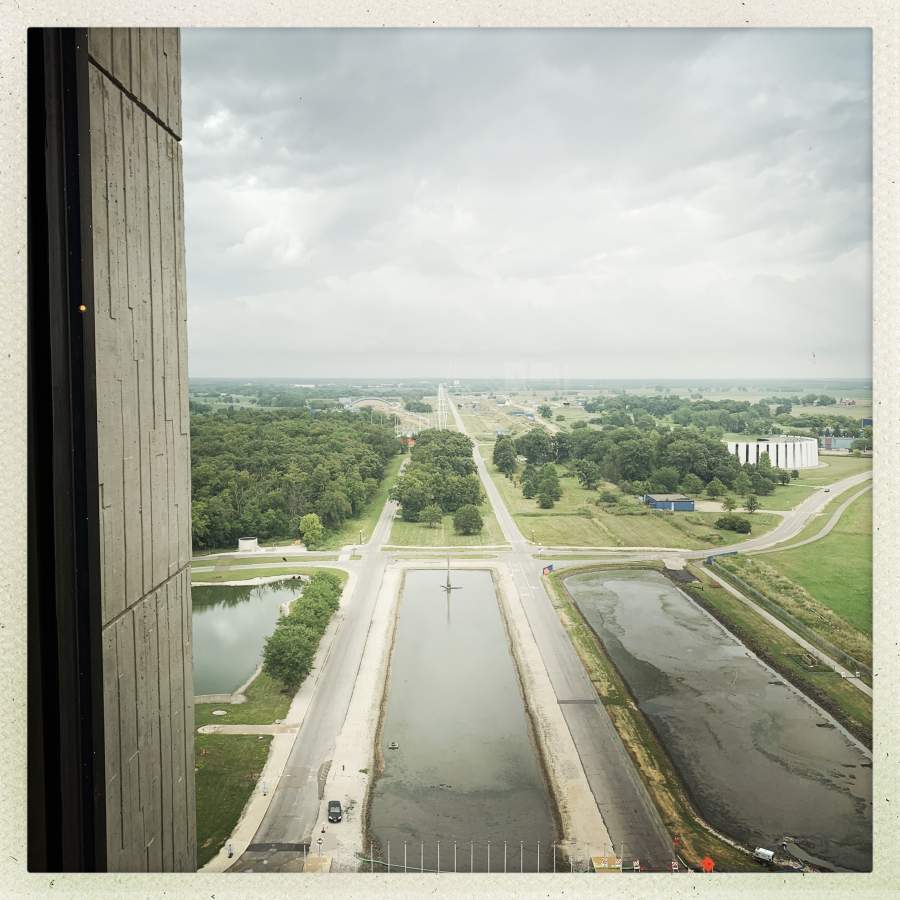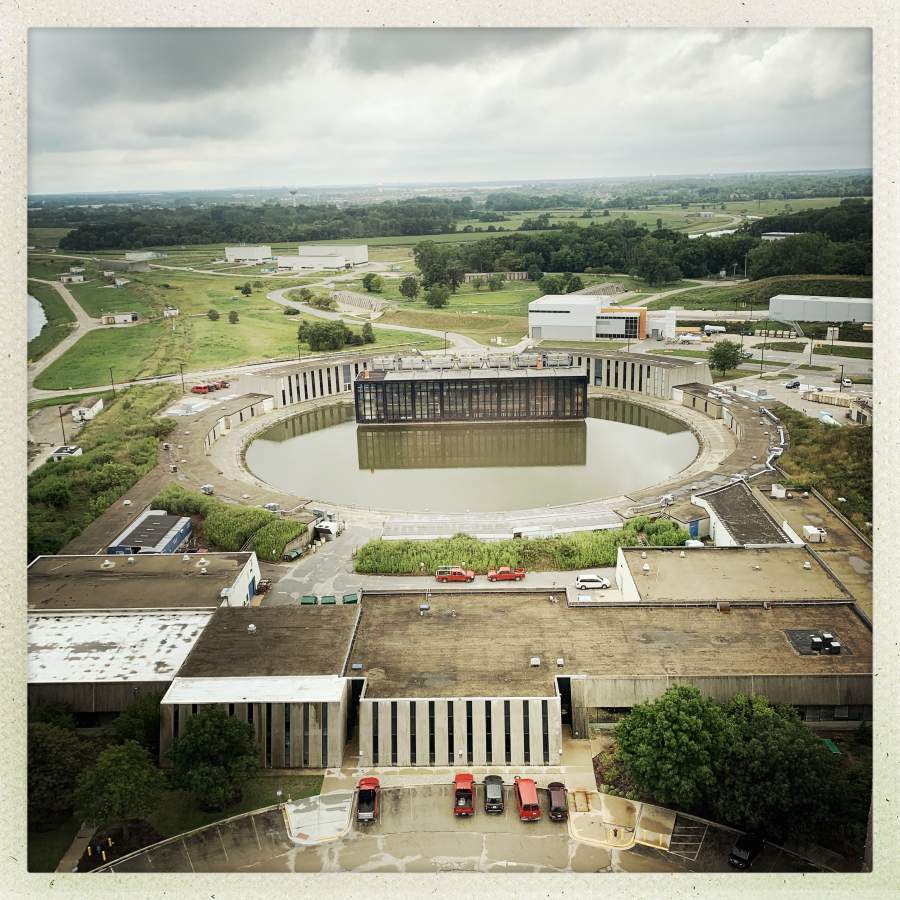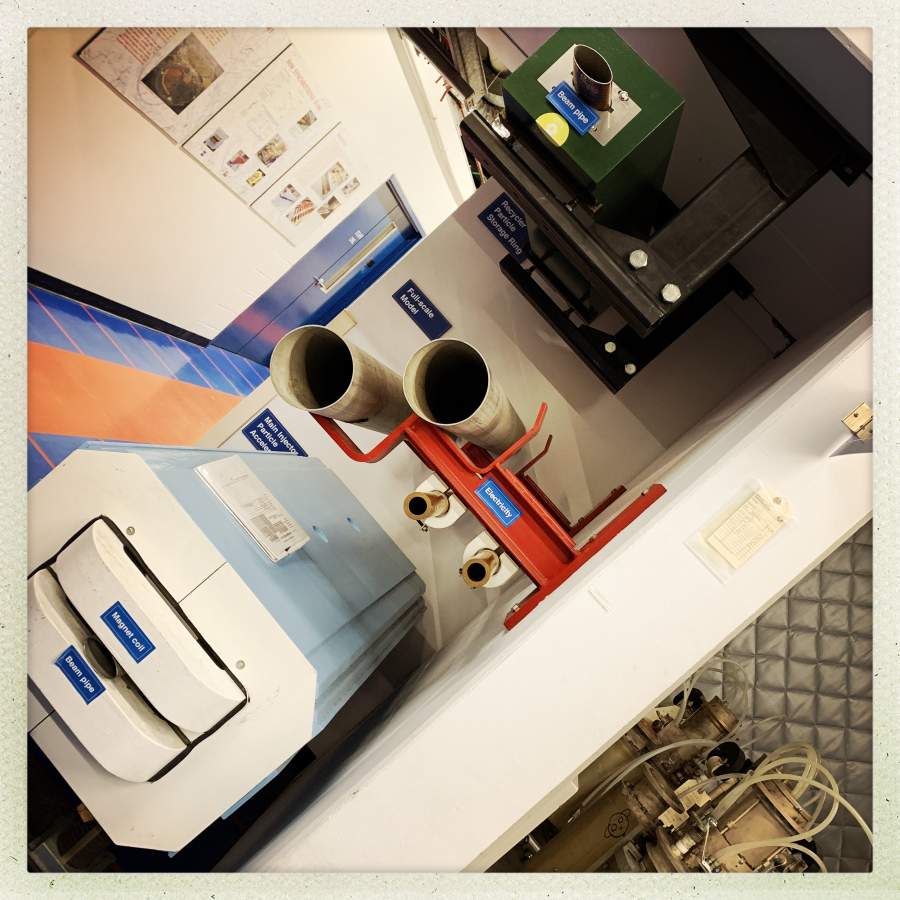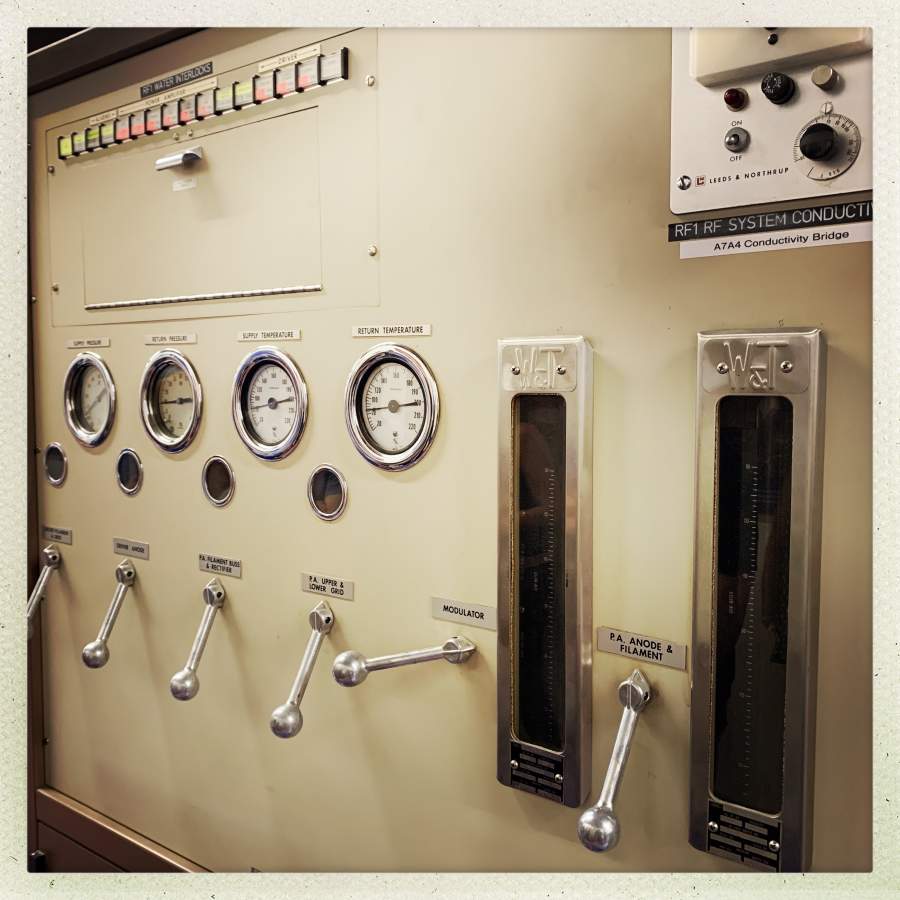Trips to Tom L.’s are always interesting. If you recall 2 years ago, at the last TomCon, we did an evening trip to Yerkes Observatory, after stuffing ourselves with a massive amount of deep-dish pizza. [stderr]
This year Tom arranged a tour at Fermilab. That was pretty darned cool! Even though the LHC is bigger, the Tevatron at Fermilab is still a really impressive piece of work. In fact I felt kind of bad for the Fermilab folks because they all had to keep saying “now the LHC is bigger…” I wish they had a different patter, perhaps a list of all the amazing things they discovered there.

It’s interesting to tour it, because most of it is underground and most of it looks the same. There’s a head unit that injects hydrogen atoms that get ripped to bits and sped up to nearly the speed of light. In the course of getting ripped to bits the various byproducts are filtered out and redirected so that what’s left is a death beam neutrino beam. The kindly fellow who was showing us around answered questions – he was getting peppered constantly by a pack of 12 very nerdy people who were extremely curious about everything.
One of the cool parts that I particularly liked is that they are helping people who are building neutrino detectors – they just figure out the right angle and send the neutrinos on their way. For example, they were sending neutrinos to Minnesota, so they just fired at an 11-degree course down into the Earth, which doesn’t slow or stop the neutrinos at all. Obviously, neutrinos are hard to modulate or we’d have neutrino-beam long haul internet and cutting oceanic fiberoptic bundles would be a non-thing.

The first director of Fermilab was a metal artist and designed a gargantuan entry gate, as well as sculptures such as this one in the fountain. He had a sense of the unusual, too – he made a 12′ mobius strip out of the stainless steel sliding covers from floppy disks.

Absolut Kelvin
I was curious where they get their liquid helium. They brew it onsite using laser cryogenics. The system uses superconductors, so the lines are chilled to a few degrees above absolute (K) zero. It’s all pretty impressive stuff but it doesn’t do anything we perceive while we’re looking at it. It doesn’t hum or glow or anything. I guess a neutrino beam is not really a “death beam” either since it’d go through you and your armor and, because at that scale you’re just a very sparse cloud of matter, you’d probably never interact with the beam at all.

The injector end of the system is in the building in front of the ring. The building in the center is air conditioning and water cooling.

That is the injector end of the loop (the blue thing on the left). I felt that there should be a big stainless steel hopper labeled “Protons” but I believe that they are actually provided from that little blue tank connected on the left of the blue thing. It doesn’t take much.
They had a big cut-away model of the superconductor loop, and it wasn’t too impressive until the fellow explained that the two large copper pipes labeled “electricity” are “wires” – those are what carries the current. Fermilab uses so much electricity that they shut down in August because the local power grid needs the juice to run air conditioners, and they don’t have to work as hard to keep the superconductors cold.

Huge amounts of space are devoted to power management and keeping electrical things cool. That makes a great deal of sense. It must be weird to be doing all this magical stuff that you can’t see doing anything (except shooting beams of neutrinos through the planet). Some of the systems look like they are right out of the 1950s, in terms of industrial aesthetics. This power distribution wossname made me squee with delight. Screw back-lit LCDs! Give me cast aluminum machinists’ levers and analog dials!
Some of the systems look like they are right out of the 1950s, in terms of industrial aesthetics. This power distribution wossname made me squee with delight. Screw back-lit LCDs! Give me cast aluminum machinists’ levers and analog dials!
One of the things that really interested me was a muon detector that was built by some gradeschoolers. It didn’t look like much, really – it was just two flat plates about 10″x10″ some framework and a small computer. I immediately started asking the docent how unpredictable the muon rate in an area was, and what the muon-rate looked like. It looks to me like muon counters would be a good place from which to sample cryptographic randomness. Since you are detecting muons that hit a spot, it would be impossible for someone who was trying to get into your RNG to sample them, too. Of course, they’d just break into the endpoint software on the controller that was measuring the samples. (sigh)
We had a good time.

The group was 90% computer security people and one blacksmith. When they walked us through the control room, there was a small spontaneous cheer. The docent asked what that was about and Tom, as our spokes-leader, said, “there are no post-it notes with passwords stuck to any of these consoles.” As soon as we walked into the room, everyone’s head was swivelling.

Actually, South Dakota, I think.
Marcus:
Obviously, neutrinos are hard to modulate or we’d have neutrino-beam long haul internet and cutting oceanic fiberoptic bundles would be a non-thing.
I believe neutrino beams are super-easy to modulate (just modulate the beam of whatever is making the neutrinos, and the neutrino flux follows that). The hard part is detecting them at the other end — the signal-to-noise ratio is so bad I doubt you can get more than a few bits per second. Or per day.
Also, there would be no Internet in August.
After the movie version of Dan Brown’s fantasy Angels and Demons came out, the local scientists had a public presentation at the library, discussing how much of the “science” was real. We were told that source of protons and anti-protons for CERN was a standard pressurized cylinder of hydrogen, which was enough to last for several years.
Fermilab: How do you make protons and antiprotons?
Well now I’m thinking about changing the label on my lab’s inorganic acid storage unit to “Protons.”
When I was an undergrad and home visiting my parents for Thanksgiving one year back in the 70’s, I went for a walk in a wooded area out west of Chicago known as “The Forest Preserves”. I took a path west into the woods and walked for maybe a mile or two. I had been reading Einstein’s biography by Ronald W. Clark and actually had a paperback copy of the book in the pocket of my parka. At some point, I thought I could shortcut over to another trail by walking through the underbrush in the woods, as it was much more passable with the leaves off for winter. I pushed my way through for some distance, and suddenly ran right into a very old and rusted chain link fence. I thought this was kind of odd, but kept walking along the fence until I came to a spot where it had collapsed. I walked over it and went another 50 yards past, when I started to make out stretches of one or two rows of old cinderblock bricks with gaps in between the stretches of bricks. As I got closer, I could see that the rows of bricks were the remains of the outer walls of a row of multiple buildings of some sort. I started to walk parallel to the row of foundations but still a bit distant from it, until I finally came to a gap between them where the underbrush was thinned out. I could see through the space that there was a large clearing in front of the row of old foundations, and in the middle of the clearing was a large, slightly pinkish granite boulder, maybe 6 or 7 feet tall. I walked in between the foundations into the clearing and toward the giant pink rock. Up to this point, I had been feeling undaunted but maybe a little weirded out by my discovery of these ruins. This was nothing though, compared to what I felt when I walked around to the other side of the granite boulder. On the opposite side from my approach was a large bronze plaque with more or less the following inscription:
`
“After initial operation at the University of Chicago, the world’s first nuclear reactors were reassembled on this site in 1946 (?). Researchers worked with these reactors for several years, and then the research facilities built around the reactors were moved to a site in northern Illinois, eventually becoming the Argonne National Laboratory. The nuclear reactors operated at this site were deactivated and buried in the ground in 1951 (?)”.
`
Or something to that effect. My mind was absolutely blown, electricity was jolting through the skin on the back of my neck. I finally sat down on the ground and calmed down a little, and started to notice how quiet and somber it seemed, a gray winter day. Suddenly, there was a very loud slapping WHACK sound, which really startled me and made me jump. After a few seconds, the WHACK sound happened again, and I realized it was coming from the opposite side of the clearing from the foundation ruins. I walked toward it, and discovered a pond with a really huge rusted pipe and 90-degree elbow sticking up out of the middle of it. As I got closer to the pond, I heard one more loud WHACK, and saw a splash and ripples in the water. I realized it had been a beaver, slapping its tail against the water to frighten me off or warn the family.
`
I found an old log to sit on near the edge of the pond and pulled out my Einstein biography. I read a few pages, but then stopped and just thought about the implications of this place, and about the people that had walked back and forth across that clearing, Fermi, maybe Einstein, others. I also thought about a post-apocalyptic world where beavers had become the dominant species.
Ooh, that control panel is giving me ideas for my next computer case :D
@ #1 Rob Grijianis
It is in Minnesota, the University of MInnesota’s Soudan Underground Laboratory, which is 2341 feet underground at the bottom of the Soudan iron mine. Quite a fascinating tour, too.
Levers! Dials!
Man, FermiLab, that’s so cool. Lately you go to the best places, Marcus!
@invivoMark: The pedant in me says: “Protons and other Stuff”, but great idea!
I agree with avalus, Marcus gets to go to some pretty awesome places. I love all the little labels on everything, and the wires, wires wires everywhere. Somehow that retro look seems super sciencey.
They can send neutrinos anywhere? Just like that?
Now I know what I’m getting all my friends and family for their birthdays from now on! (Or at least what I’m telling them they got.)
Oooh, cue conspiracy theories! Bob’s had an accident because he was blinded by a neutrino beam from Fermilabs! The second gunman involved in the JFK hit was a CIA agent from 2034 using a time-shifted neutrino beam fired from their hand-held discombobulotron. Wake up, people! Also, stay safe by drinking plenty of rum. The resulting
drunken staggerrandom walk will protect you from neutrino beams which must be pretty tricky to steer.Fermilabs might become an unusal casualty of global warming then. Longer, more frequent and severe heatwaves might overtax the power grid over long stretches of time. They could also push cooling systems over the brink or at least to the point where it becomes completely uneconomic (and irresponsibly wasteful) to run them anyway.
Nuclear power stations in Europe have had similar problems during previous heatwaves: if they draw their coolant from a river and the river gets too warm they have to shut down. For now that has only affected stations where the water is fed straight back into the river, and only due to environmental concerns (they aren’t allowed dump too much warm water into river to protect the ecosystem) rather than technical limitations. But it’s only going to get worse.
Maybe there were loads of login screens visible, I don’t know, but if not, did you consider the possibility that there weren’t any passwords? The password might be universal. Maybe its the room number on the door. It might be “42” and everybody from intern to janitor to the head neutrino wrangler might now it. Don’t mind me, I’m just here to spoil things.
—
Re: Curt Sampson (#8):
That’s a nice idea but I think I’d stick to solar neutrinos as green, carbon-neutral and ethically sourced.
I was last there several years ago but from what I recall, Fermilab is (or at least was) pretty involved with the LHC actually. At the time they didn’t have an active particle accelerator but as I understood it they were one of the premier spots in the world for receiving and processing the raw data from the LHC.
I also kind of get the sense that you could tour there every day for a week, talk to different people and get a different sense of the scope of the science going on there each day.
I’d probably be working there now if I had a college degree. They’re one of the few employers I’ve run across who list a degree requirement for a linux job and stick to it.
What an amazing field trip. I has envy.
lanir@#12:
I also kind of get the sense that you could tour there every day for a week, talk to different people and get a different sense of the scope of the science going on there each day.
Yes! It’s so cool when you scratch the surface at a science lab because everyone is doing something different but, in this case, it all revolves around things that have to do with neutrino beams.
I’d probably be working there now if I had a college degree. They’re one of the few employers I’ve run across who list a degree requirement for a linux job and stick to it.
I am always disappointed when I see organizations that exclude good people because of certifications or qualifications. I believe a resume should speak for itself. One of the best programmers I had at NFR was a waiter at a thai restaurant where some of us were having a design meeting. He said “I overheard you guys talking about C code and I’ve been teaching myself UNIX/C. Do you have any openings?” We talked a bit and determined that he seemed to be able to do entry-level stuff and I hired him on the spot with an entry-level salary and the understanding that if he couldn’t cut it we’d let him go in 3 months. It turned out he also knew some MFC stuff and wound up writing our 1st generation user interface in ridiculously short order. He kicked major ass and was one of our top engineers within 2 years, and when he left the company he went to VMware, did some gnarly stuff in the core of their packet-shuffling routines, made himself a multimillionaire on stock options and is a venture capitalist now. Ugh. So much potential and he turned into a VC!
Often if you can get past the HR people and talk to someone who is actually trying to do things instead of act as a gatekeeper, you can appeal directly to them and get in the door. It’s hard, though, and some organizations like Google and Amazon have gone the other route and weaponized their interview process to humiliate and obscure. Ugh. You can tell a lot about an organization by how they interview people. I’m surprised that there is an HR at a science lab that doesn’t need linux sysadmins. :/ I know I’m privileged as hell but I’ve been asked what my certifications are and I usually just list the certification programs that reference my work, or that I helped develop. I feel certification programs are laziness and are just a way to allow incompetent HR people to hire people they do not understand.
komarov@#11:
Maybe there were loads of login screens visible, I don’t know, but if not, did you consider the possibility that there weren’t any passwords? The password might be universal.
Because my friend Jayson Street was not with us, we did not have problems like Jayson running over and typing things into command windows. There are some people who really can’t keep from pushing buttons that say “DO NOT PUSH”
Reginald Selkirk@#3:
After the movie version of Dan Brown’s fantasy Angels and Demons came out, the local scientists had a public presentation at the library, discussing how much of the “science” was real. We were told that source of protons and anti-protons for CERN was a standard pressurized cylinder of hydrogen, which was enough to last for several years.
The fellow who was guiding us about made a point of asking if any of us had heard about the antimatter that they make and if we had any idea how much they had created. None of us had any idea (but several of us had heard about the antimatter)
Turns out to be about a total of a nanogram, which Tom L and I instantly raced to calculate the yield of if it was used in a matter/antimatter bomb in the Vatican. Tom went forward from E=MC2 and I went backward from memory using the yield of the Nagasaki device and the amount of uranium it allegedly converted (~700mg) and came up with about the same answer* – it’d be about like having 10-20 tons of TNT go off at once. Definitely a “pop” but not a weapon of mass destruction.
(I’m damned if I recall how to convert joules into sticks of TNT)
Marcus @16: One (or more) of us did our sums wrong. I get about 2e5 joules, or about 0.00004 tons of TNT from 1 nanogram antimatter.
Rob Grigjanis@#17:
I get about 2e5 joules, or about 0.00004 tons of TNT from 1 nanogram antimatter.
So that’s about an M-80 worth?
Well, my estimates are based on 700mg of uranium being converted to energy to yield 25,000 tons TNT equivalent at Nagasaki (the Nagasaki bomb was higher yield and more efficient, which I chose because a matter/antimatter reaction would be completely efficient) So that comes out to 35t/mg which shifts 6 decimal places to get billionths and oooops. Tequila was involved. So that’s .071lb of TNT/nanogram.
That’s about an M-80 worth. You’d hear it go off, though!
That’s kind of disappointing: “I had 1 nanogram of antimatter and all it did was blow my finger off.”
How did you get your number? Did you go from joules->TNT conversion, or some other method? Either way, you’re right(er) than I was.
Marcus @18: E=mc². mass 2e(-12) kg, c=3e8 m/s. So
2e(-12) x 9e16 joules = 1.8e5 joules.
First, I reckoned that’s the output from about 15 minutes pedalling on my stationary bike, so probably not a big bang. Then looked up TNT equivalent; 4.2e9 joules per ton TNT.
(1.8e5)/4.2e9 = about 4e(-5) tons TNT
Gin works better for calculations.
So… 40 grams of TNT? That puts me in mind of lighting an oven with a bit too much gas built up in it – more a whuuuuff than a bang.
https://what-if.xkcd.com/73/